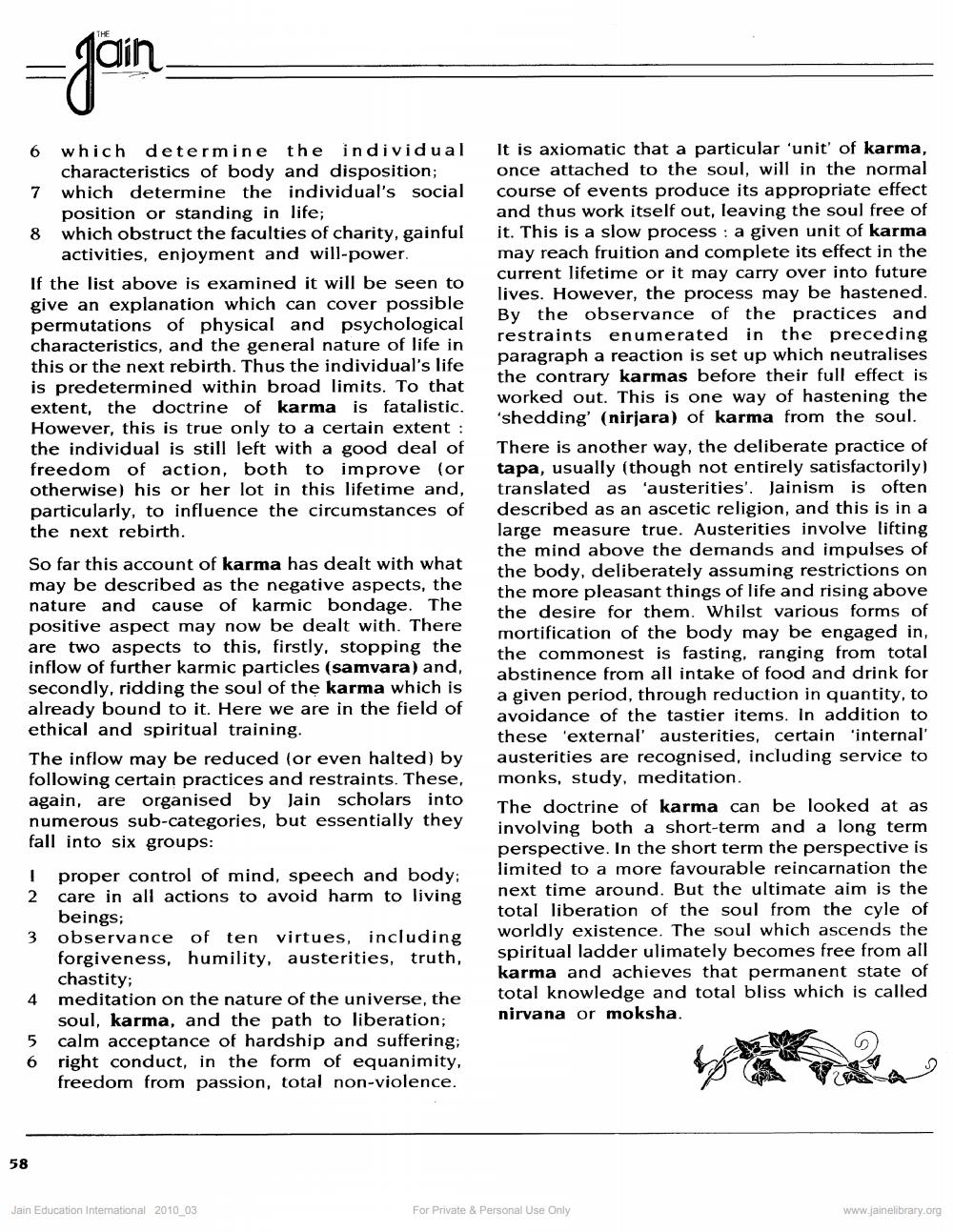________________
slain
6 which determine the individual
characteristics of body and disposition; 7 which determine the individual's social
position or standing in life; 8 which obstruct the faculties of charity, gainful
activities, enjoyment and will-power. If the list above is examined it will be seen to give an explanation which can cover possible permutations of physical and psychological characteristics, and the general nature of life in this or the next rebirth. Thus the individual's life is predetermined within broad limits. To that extent, the doctrine of karma is fatalistic. However, this is true only to a certain extent : the individual is still left with a good deal of freedom of action, both to improve (or otherwise) his or her lot in this lifetime and, particularly, to influence the circumstances of the next rebirth. So far this account of karma has dealt with what may be described as the negative aspects, the nature and cause of karmic bondage. The positive aspect may now be dealt with. There are two aspects to this, firstly, stopping the inflow of further karmic particles (samvara) and, secondly, ridding the soul of the karma which is already bound to it. Here we are in the field of ethical and spiritual training. The inflow may be reduced (or even halted) by following certain practices and restraints. These, again, are organised by Jain scholars into numerous sub-categories, but essentially they fall into six groups: I proper control of mind, speech and body; 2 care in all actions to avoid harm to living
beings; 3 observance of ten virtues, including
forgiveness, humility, austerities, truth,
chastity; 4 meditation on the nature of the universe, the
soul, karma, and the path to liberation;
calm acceptance of hardship and suffering; 6 right conduct, in the form of equanimity,
freedom from passion, total non-violence.
It is axiomatic that a particular 'unit' of karma, once attached to the soul, will in the normal course of events produce its appropriate effect and thus work itself out, leaving the soul free of it. This is a slow process : a given unit of karma may reach fruition and complete its effect in the current lifetime or it may carry over into future lives. However, the process may be hastened. By the observance of the practices and restraints enumerated in the preceding paragraph a reaction is set up which neutralises the contrary karmas before their full effect is worked out. This is one way of hastening the 'shedding' (nirjara) of karma from the soul. There is another way, the deliberate practice of tapa, usually (though not entirely satisfactorily) translated as 'austerities'. Jainism is often described as an ascetic religion, and this is in a large measure true. Austerities involve lifting the mind above the demands and impulses of the body, deliberately assuming restrictions on the more pleasant things of life and rising above the desire for them. Whilst various forms of mortification of the body may be engaged in, the commonest is fasting, ranging from total abstinence from all intake of food and drink for a given period, through reduction in quantity, to avoidance of the tastier items. In addition to these 'external austerities, certain 'internal' austerities are recognised, including service to monks, study, meditation. The doctrine of karma can be looked at as involving both a short-term and a long term perspective. In the short term the perspective is limited to a more favourable reincarnation the next time around. But the ultimate aim is the total liberation of the soul from the cyle of worldly existence. The soul which ascends the spiritual ladder ulimately becomes free from all karma and achieves that permanent state of total knowledge and total bliss which is called nirvana or moksha.
58
Jain Education Intemational 2010_03
For Private & Personal Use Only
www.jainelibrary.org




